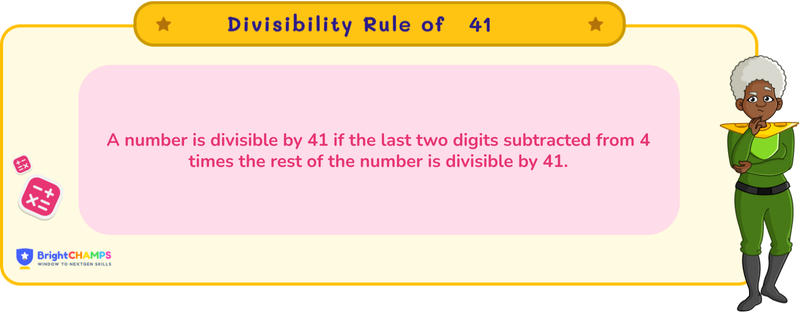
 210 Learners
210 LearnersLast updated on May 26th, 2025

Divisibility Rule of 41

The divisibility rule is a way to find out whether a number is divisible by another number without using the division method. In real life, we can use the divisibility rule for quick math, dividing things evenly, and sorting things. In this topic, we will learn about the divisibility rule of 41.
What is the Divisibility Rule of 41?
The divisibility rule for 41 is a method by which we can determine if a number is divisible by 41 without using the division method. Check whether 2465 is divisible by 41 with the divisibility rule.
Step 1: Multiply the last digit of the number by 4, here in 2465, 5 is the last digit. Multiply it by 4. 5 × 4 = 20
Step 2: Subtract the result from Step 1 from the remaining values but do not include the last digit. i.e., 246–20 = 226.
Step 3: As it is shown that 226 is a multiple of 41, the number is divisible by 41. If the result from step 2 isn't a multiple of 41, then the number isn't divisible by 41.
Struggling with Math?
Get 1:1 Coaching to Boost Grades Fast !

Tips and Tricks for Divisibility Rule of 41
Learning the divisibility rule will help kids master division. Let’s learn a few tips and tricks for the divisibility rule of 41.
Know the multiples of 41:
Memorize the multiples of 41 (41, 82, 123, 164, 205, etc.) to quickly check the divisibility. If the result from the subtraction is a multiple of 41, then the number is divisible by 41.
Use negative numbers:
If the result we get after the subtraction is negative, we will ignore the symbol and consider it as positive for checking the divisibility of a number.
Repeat the process for large numbers:
Students should keep repeating the divisibility process until they reach a small number that is divisible by 41.
For example: Check if 8612 is divisible by 41 using the divisibility test.
Multiply the last digit by 4, i.e., 2 × 4 = 8.
Subtract the remaining digits excluding the last digit by 8, 861–8 = 853.
Since 853 is a large number, repeat the process: 3 × 4 = 12.
Subtract 12 from 85 (excluding the last digit), 85–12 = 73.
Since 73 is not a multiple of 41, 8612 is not divisible by 41.
Use the division method to verify:
Students can use the division method as a way to verify and cross-check their results. This will help them verify and also learn.

Common Mistakes and How to Avoid Them in Divisibility Rule of 41
The divisibility rule of 41 helps us quickly check if a given number is divisible by 41, but common mistakes like calculation errors lead to incorrect results. Here we will understand some common mistakes and how to avoid them.
Level Up with a Math Certification!
2X Faster Learning (Grades 1-12)


Divisibility Rule of 41 Examples

Problem 1
Is 1640 divisible by 41?

Yes, 1640 is divisible by 41.
Explanation
To check the divisibility rule of 41 for 1640, we can use the known result that 410 is a multiple of 41.
1) Divide 1640 by 410, since 1640 ÷ 410 = 4, which is an integer,
2) Therefore, 1640 is divisible by 41.

Problem 2
Check the divisibility rule of 41 for 1230.

No, 1230 is not divisible by 41.
Explanation
To determine if 1230 is divisible by 41,
1) We know that 1230 is around 1234, which is 41 x 30.
2) When we subtract 41 from 1234, we get 1193, which is not a multiple of 41.
3) Therefore, 1230 is not divisible by 41.

Problem 3
Is -205 divisible by 41?

Yes, -205 is divisible by 41.
Explanation
To check if -205 is divisible by 41,
1) Remove the negative sign and consider 205.
2) Divide 205 by 41, which results in 5 (41 x 5 = 205).
3) Thus, -205 is divisible by 41.

Problem 4
Can 820 be divisible by 41 following the divisibility rule?

Yes, 820 is divisible by 41.
Explanation
To verify if 820 is divisible by 41,
1) Use the known result that 820 is exactly 41 x 20.
2) Therefore, 820 is divisible by 41.

Problem 5
Check the divisibility rule of 41 for 287.

No, 287 is not divisible by 41.
Explanation
To determine if 287 is divisible by 41,
1) We know that 287 is close to 246, which is 41 x 6.
2) Subtracting 246 from 287, we get 41, which is a multiple of 41.
3) However, this subtraction does not align with any multiple of 41 directly from 287, hence 287 is not divisible by 41.

Turn your child into a math star!
#1 Math Hack Schools Won't Teach!


FAQs on Divisibility Rule of 41
1.What is the divisibility rule for 41?
2.How many numbers are there between 1 and 100 that are divisible by 41?
3.Is 123 divisible by 41?
4.What if I get 0 after subtracting?
5.Does the divisibility rule of 41 apply to all integers?
6.How can children in Singapore use numbers in everyday life to understand Divisibility Rule of 41?
7.What are some fun ways kids in Singapore can practice Divisibility Rule of 41 with numbers?
8.What role do numbers and Divisibility Rule of 41 play in helping children in Singapore develop problem-solving skills?
9.How can families in Singapore create number-rich environments to improve Divisibility Rule of 41 skills?
Struggling with Math?
Get 1:1 Coaching to Boost Grades Fast !

Important Glossaries for Divisibility Rule of 41
- Divisibility rule: A set of rules used to determine whether a number is divisible by another number without direct division. For example, a number is divisible by 2 if it ends in an even number.
- Multiples: These are the results obtained by multiplying a number by an integer. For example, multiples of 41 are 41, 82, 123, 164, etc.
- Integers: Integers include all whole numbers, negative numbers, and zero.
- Subtraction: Subtraction is the process of finding the difference between two numbers by reducing one number from another.
- Verification: The process of confirming the correctness of a result, often by using a different method such as direct division.
Explore More numbers
![Important Math Links Icon]() Previous to Divisibility Rule of 41
Previous to Divisibility Rule of 41
About BrightChamps in Singapore


Seyed Ali Fathima S
About the Author
Seyed Ali Fathima S a math expert with nearly 5 years of experience as a math teacher. From an engineer to a math teacher, shows her passion for math and teaching. She is a calculator queen, who loves tables and she turns tables to puzzles and songs.
Fun Fact
: She has songs for each table which helps her to remember the tables




